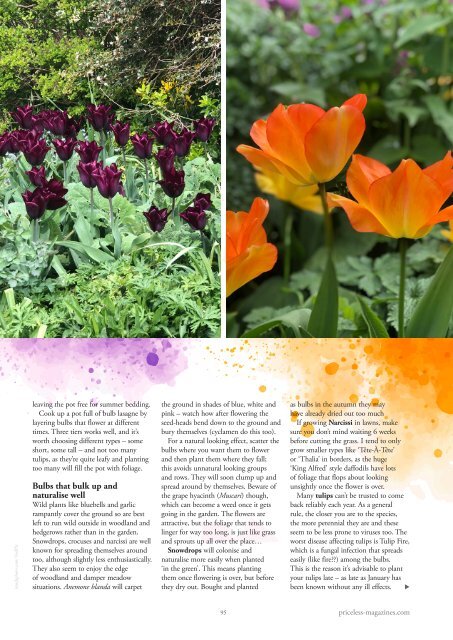Wealden Times | WT257 | October 2023 | Interiors & Bathrooms Supplement inside
The lifestyle magazine for Kent & Sussex - Inspirational Interiors, Fabulous Fashion, Delicious Dishes
The lifestyle magazine for Kent & Sussex - Inspirational Interiors, Fabulous Fashion, Delicious Dishes
You also want an ePaper? Increase the reach of your titles
YUMPU automatically turns print PDFs into web optimized ePapers that Google loves.
istockphoto.com/ FeelPic<br />
leaving the pot free for summer bedding.<br />
Cook up a pot full of bulb lasagne by<br />
layering bulbs that flower at different<br />
times. Three tiers works well, and it’s<br />
worth choosing different types – some<br />
short, some tall – and not too many<br />
tulips, as they’re quite leafy and planting<br />
too many will fill the pot with foliage.<br />
Bulbs that bulk up and<br />
naturalise well<br />
Wild plants like bluebells and garlic<br />
rampantly cover the ground so are best<br />
left to run wild outside in woodland and<br />
hedgerows rather than in the garden.<br />
Snowdrops, crocuses and narcissi are well<br />
known for spreading themselves around<br />
too, although slightly less enthusiastically.<br />
They also seem to enjoy the edge<br />
of woodland and damper meadow<br />
situations. Anemone blanda will carpet<br />
the ground in shades of blue, white and<br />
pink – watch how after flowering the<br />
seed-heads bend down to the ground and<br />
bury themselves (cyclamen do this too).<br />
For a natural looking effect, scatter the<br />
bulbs where you want them to flower<br />
and then plant them where they fall;<br />
this avoids unnatural looking groups<br />
and rows. They will soon clump up and<br />
spread around by themselves. Beware of<br />
the grape hyacinth (Muscari) though,<br />
which can become a weed once it gets<br />
going in the garden. The flowers are<br />
attractive, but the foliage that tends to<br />
linger for way too long, is just like grass<br />
and sprouts up all over the place…<br />
Snowdrops will colonise and<br />
naturalise more easily when planted<br />
‘in the green’. This means planting<br />
them once flowering is over, but before<br />
they dry out. Bought and planted<br />
as bulbs in the autumn they may<br />
have already dried out too much<br />
If growing Narcissi in lawns, make<br />
sure you don’t mind waiting 6 weeks<br />
before cutting the grass. I tend to only<br />
grow smaller types like ‘Tête-À-Tête’<br />
or ‘Thalia’ in borders, as the huge<br />
‘King Alfred’ style daffodils have lots<br />
of foliage that flops about looking<br />
unsightly once the flower is over.<br />
Many tulips can’t be trusted to come<br />
back reliably each year. As a general<br />
rule, the closer you are to the species,<br />
the more perennial they are and these<br />
seem to be less prone to viruses too. The<br />
worst disease affecting tulips is Tulip Fire,<br />
which is a fungal infection that spreads<br />
easily (like fire??) among the bulbs.<br />
This is the reason it’s advisable to plant<br />
your tulips late – as late as January has<br />
been known without any ill effects. <br />
95<br />
priceless-magazines.com


















